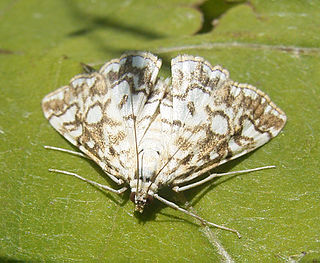
Swinhoe's storm petrel or Swinhoe's petrel is a small, all-brown seabird of the storm petrel family Hydrobatidae.

Robert Swinhoe FRS was an English diplomat and naturalist who worked as a Consul in Taiwan. He catalogued many Southeast Asian birds, and several, such as Swinhoe's pheasant, are named after him.
Colonel Charles Swinhoe was an English naturalist and lepidopterist, who served in the British Army in India. He was one of the eight founders of the Bombay Natural History Society and a brother of the famous naturalist Robert Swinhoe.

Cornhill-on-Tweed is a small village and civil parish in Northumberland, England about 1 mile (1.6 km) to the east of Coldstream, Scotland. The hamlets of West Learmouth and East Learmouth are located to the south and west of the village respectively. In 2011 the parish had a population of 347.

Spilomelinae is a very species-rich subfamily of the lepidopteran family Crambidae, the crambid snout moths. With 4,135 described species in 344 genera worldwide, it is the most speciose group among pyraloids.

Swinhoe's pheasant, also known as the Taiwan blue pheasant, is a bird of the pheasant subfamily in the fowl family Phasianidae. It is endemic to Taiwan. Along with the Mikado pheasant and Taiwan blue magpie, two other Taiwan endemics, Swinhoe's pheasant is sometimes considered an unofficial national symbol for Taiwan, as it bears the colours of the national flag.

Swinhoe's striped squirrel is a small species of rodent in the family Sciuridae. This species is found mostly in China and Southeast Asia. Their diet consists of mostly seeds, fruits, nuts and ginger nectar. Like most squirrels they live in forest areas with mountains, usually in groups. They have litters that average in size of 3.25 offspring.

Erebus is a genus of moths in the family Erebidae.

Thliptoceras is a genus of moths of the family Crambidae. The genus was erected by William Warren in 1890.

Anomis is a genus of moths in the family Erebidae.

Bocula is a genus of moths in the family Erebidae. The genus was erected by Achille Guenée in 1852.

Chilkasa is a monotypic moth genus in the family Erebidae. Its only species, Chilkasa falcata, is found in India, Thailand, Peninsular Malaysia, Sumatra, Borneo and the Philippines. Both the genus and the species were first described by Swinhoe in 1885.

Rivula is a genus of moths in the family Erebidae described by Achille Guenée in 1845.

Arctornis is a genus of tussock moths in the family Erebidae, the namesake of the tribe Arctornithini, and disputedly the sole genus in the tribe. The genus was erected by Ernst Friedrich Germar in 1810.
Stracena is a genus of moths in the subfamily Lymantriinae. The genus was erected by Charles Swinhoe in 1903.

Chrysocraspeda is a genus of moths in the family Geometridae described by Charles Swinhoe in 1893.

Herochroma is a genus of moths in the family Geometridae. The genus was described by Charles Swinhoe in 1893.

Acentropinae is a fairly small subfamily of the lepidopteran family Crambidae, the crambid snout moths. Species of this subfamily are exclusively found in wetlands and aquatic habitats.

Margaroniini is a tribe of the species-rich subfamily Spilomelinae in the pyraloid moth family Crambidae. The tribe was erected by Charles Swinhoe and Everard Charles Cotes in 1889, originally as family Margaronidae.
















